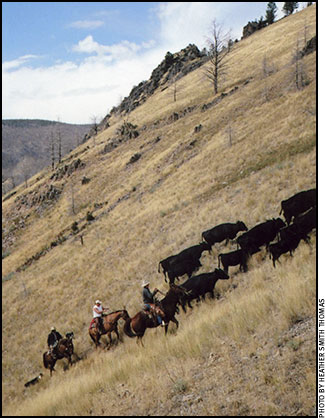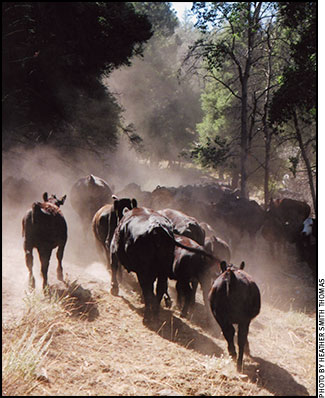Notice the Stress
Know the signs of heat stress in your cattle when working them.
On a hot day, cattle overheat quickly if they exert. Moving cattle is always safer during the coolest part of the day, starting early in the morning, if possible. Julie Walker, beef specialist for South Dakota State University, says it’s also important to let cattle go their own speed. Don’t hurry them. Low-stress handling is better, especially if it’s going to be a hot day.

If it’s a hot day, cattle accumulate body heat so it’s best to start out when they are cooler. Calves often suffer heat stress when moved in the heat of the day, and may show signs of heat stress before cows do.
Also watch for signs of heat stress and give cattle a rest if some of them start to overheat.
“The first signs will be fast respiration and panting, breathing with mouth open, and excessive salivation. If you push them farther, you’d see some of them start stumbling and staggering,” she says.
If it’s a hot day, cattle accumulate body heat so it’s best to start out when they are cooler. Calves often suffer heat stress when moved in the heat of the day, and may show signs of heat stress before cows do.
“They [calves] may start panting and trying to lie down, even before the cows are stressed. More people are moving their calving to April and May instead of February-March, to match forage with nutritional needs of the lactating cow (and reduce labor at calving, not having to worry about cold weather) so now they have to deal with heat instead, especially during breeding season. If producers are heat synchronizing for that first cycle, they are potentially working cattle during the hotter part of the day,” says Walker.
It pays to watch weather forecasts and try to choose a day that won’t be during a heat wave. Sometimes, however, people need to get cattle in for processing in a heat-synchronization program, and timing is crucial, regardless of weather.

Often, people just focus on the heat that builds up during the day and forget that perhaps it wasn’t alleviated the night before, since heat can become cumulative in cattle when they don’t have a chance to cool off at night.
The livestock weather hazard guide has three conditions that will put cattle into heat stress, in addition to just temperature, humidity, wind and solar radiation.
Walker advises to be on the lookout for heat index at three different times. The first is the daytime heat index at 75° F or higher for 72 hours. The second is the heat index during a 48-hour period that is no lower than 79° during the day and no lower than 75° at night. The third is the daytime heat index reaching 84° or higher for two consecutive days.
Often, people just focus on the heat that builds up during the day and forget that perhaps it wasn’t alleviated the night before, since heat can become cumulative in cattle when they don’t have a chance to cool off at night. If it was a warm night, cattle start the day warmer than expected, and it might not be a good morning for a long cattle drive.
“There are apps available that give this weather information, and cattlemen can put these on their smartphone. One is called Thermal Aid, but there are several out there. You can program it to alert you when there is risk for heat stress. These can monitor a lot of things for you,” says Walker.
Also pay attention to signs of heat stress in horses and dogs, if using them when moving cattle.
“Dogs do a lot more running; they are traveling more miles than the cattle or horses,” she points out. They can overheat quickly on a hot day if they don’t have some water along the way to flop into, like a stream or water tank.

Editor’s Note: Heather Smith Thomas is a cattlewoman and freelance writer from Salmon, Idaho.






